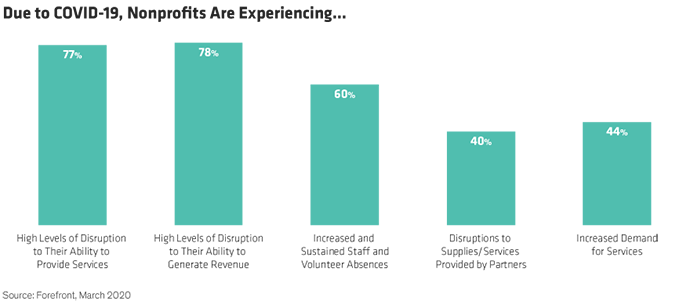The COVID-19 pandemic is exposing—and exacerbating—vulnerabilities nonprofits have faced for years, thanks to a decline in charitable giving and other critical resources. Now, as donors grapple with financial uncertainty, and demand for social services has skyrocketed, nonprofits confront a new challenge: engaging funders and ramping up their outreach efforts. Fortunately, savvy nonprofits can draw upon lessons from past crises to become stronger today and better prepared for tomorrow.
Widespread Disruption Amid Increased Demand
The coronavirus is disrupting daily life—and nonprofits aren’t immune. A recent survey of over 1,300 nonprofits found that roughly 80% have already experienced a significant impact, which they anticipate will only intensify (Display). At the same time, nearly half say that demand for their services has increased.*

Coping with Chronic Shortfalls
Even before the outbreak, a decline in individual giving over the last two years put many nonprofits in a precarious position. And it appears there’s no end in sight. The Lilly School of Philanthropy estimates that each year, up to 2.6 million fewer households will be inclined to donate. Should this come to fruition, charitable giving could decline by $19.1 billion annually, due in large part to donor disincentives embedded in recent tax law changes.†
What about the recently enacted fiscal stimulus bill, the CARES Act? While encouraging, it only partially rolls back previous amendments. And when the decline is coupled with increased market volatility, nonprofit resources seem destined to work harder than in the past, even before COVID-19.
Learning from the Past
While these headwinds are worrisome, past crises provide valuable insights for surviving turbulent times—and thriving afterward. Two lessons in particular stand out:
- Diversify funding sources: Just over ten years ago, the Great Financial Crisis hurt millions. Yet as demand for their services soared, nonprofits proved highly adaptive. While some lost upward of 20% of their assets or never fully recovered, others emerged healthier. Take educational and medical institutions. By seeking out new sources of funding, they grew revenue by 2.8% despite gifts declining by 11.8%.‡
- Make programs relevant: Likewise, 9/11 affected many of the same businesses currently impacted by the coronavirus crisis today. Following the attacks, many successful nonprofits pivoted to disaster relief, thereby making themselves relevant. Does this mean that if you are an arts-based nonprofit you should redirect funding to emergency services like food banks and homeless shelters? No, but you can scrutinize programs to see if they are truly “mission-critical” and aligned with your founding charter.
Future-Proof Your Mission
Are there other near-term tactics for nonprofits struggling to survive? Below we distill several from experts in the field:
- Pursue cross-sector collaboration—including with the private sector—to foster social good.
- Support each other through outreach to peer organizations and investigate possible mergers or acquisitions.
- Diversify revenue streams and engage in different and more strategic fundraising efforts.
- Reassess suppliers based on who will accommodate you on pricing and services. Pursue economies of scale, doing your purchasing homework to free up cash flow. Reconsider priority purchases to determine if they’re critical.
- Invest in technology.
Financial strength has, all too often, not been a central priority for the nonprofit community. But in the face of the current crisis, there’s a more pressing need to collaborate—financially, with buying initiatives, and between programs.
What About Donor Outreach?
Organizations also need to rethink fundraising strategies. While annual fundraising efforts—such as events, galas, and other in-person meetings—have been postponed, donors are likely facing near-term financial hits. How should nonprofits communicate with givers during the pandemic? Should they make direct asks?
Eric Weinheimer, President and CEO of Forefront, addresses this complicated issue. He advises organizations to acknowledge the country’s unique situation, as well as donors’ fears and anxieties. “Use creative and strategic storytelling to bridge the current physical divide created by distancing and quarantining,” he suggests, “which inadvertently creates less awareness of the most vulnerable.”
In other words, proximity creates understanding—and its current absence is a major hurdle. Compelling storytelling reminds donors of the crucial work nonprofits are currently doing, while simultaneously making an implicit ask to support local communities’ growing needs. “Highlight ways you are innovating and adapting to stay relevant in this and future moments,” suggests Weinheimer. And don’t forget gratitude!
COVID-19: Catalyst for Change?
Though the future remains uncertain, the story of the nonprofit sector has historically been one of innovation and flexibility in service to the most vulnerable. We’re confident its response to the COVID-19 pandemic will be no different.
* https://myforefront.org/wp-content/uploads/2020/03/Forefront-COVID-19-Nonprofit-Report-3.24.20.pdf
† https://scholarworks.iupui.edu/bitstream/handle/1805/19515/tax-policy190603.pdf, estimates are between 2018-2025
‡ https://nonprofitquarterly.org/deconstructing-the-not-so-great-nonprofit-recession/
§ https://nonprofitquarterly.org/the-great-recession-nonprofit-winners-and-losers/
For more on timely topics for nonprofits, explore “Inspired Investing,” a Bernstein podcast series that covers investing, spending, policy, and more for Endowments & Foundations, and for additional thought leadership, check out the related blogs here.
- Margaret Borrasso
- Associate Director—Foundation & Institutional Advisory

